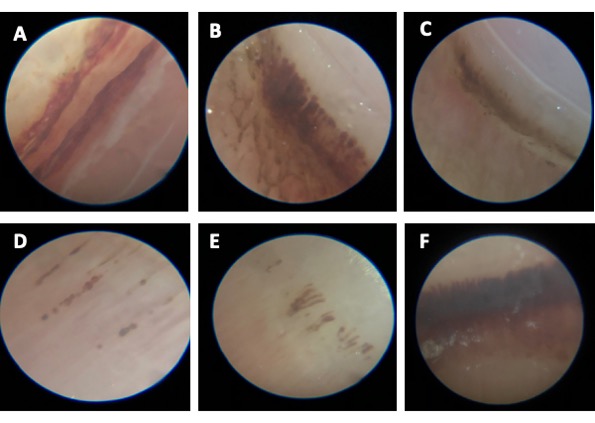Session Information
Session Type: Poster Session D
Session Time: 8:30AM-10:30AM
Background/Purpose: Nailfold capillaroscopy is a relatively easy-to-access, low-cost clinical tool that could help identify early coagulopathy in subjects with SARS-CoV-2, but specific findings vs. controls and its possible prognostic role has not been studied.
Methods: We designed a cross-sectional study, carried out in a single care center for critical patients with SARS-CoV-2 pneumonia at the ABC Medical Center, Mexico City, which included patients from an intensive care unit (ICU) and internal medicine ward from March to April 2020. Demographic, biochemical and clinical features were collected. All patients signed the informed consent and the study was approved by the hospital ethics committee. All patients underwent nail capillary imaging of the 3 central fingers of each hand with a portable microscope with 100x magnification coupled to a smartphone with 7 megapixel images in an immersion medium. Capillaroscopy was performed in patients who didn´t have fever or hypothermia, or need vasopressors at the time of evaluation. Control subjects are healthy subjects matched on age and sex from a database of healthy controls without rheumatic diseases. Image evaluation of COVID-19 patients was performed in a blinded way for their characteristics. Prior to the analysis, a pilot test was obtained with 4 rheumatologists in random cases, obtaining an acceptable global agreement in the visualization of capillaries and alterations. (Kappa=0.58, p=0.0019). Obtained data from capillaroscopies were used to be compared between severe and moderate cases of COVID-19. Additionally, we compared the findings against a healthy population in order to establish a reference.
Results: We included data from 27 patients and 32 controls with similar demographic features. Patients with COVID-19 patients had a mean age of 43 +/- 13.8 years, 63% female. Comorbidities were present in 44.4% with: type 2 Diabetes Mellitus 18.5%, systemic hypertension 18.5%, and rheumatoid arthritis 3.7%. The mean length of stay time was 13 +/- 7.1 days, 48.1% were admitted to the ICU, and 40.7% required invasive mechanical ventilation. In the capillaroscopic review remarkable findings of patients vs. controls were hemosiderin deposits (33 vs 12.5%, p=0.05), less frequently observable capillaries (77 vs 100%, p=0.005), any abnormality in capillaries (25.9 vs. 6.3%, p=0.03). Of notice, specific findings in COVID-19 patients were capillary tortuosities in 19%, dilatation 9.5%, serpentine pattern 4.8%, bush pattern 9.5% and decreased density in only 4.8% of the cases. Avascular areas or capillaries of neoformation were not observed. The presence of hemosiderin was associated with worse presentation and risk factors for severe COVID-19: male sex 66.7 vs. 27.8%, (p = 0.024); Admission to ICU 77% vs 33% (p = 0.029); obesity 66.7 vs. 27.8% (p = 0.053). And risk for ICU admission OR = 7.0 (95% CI 1.098 – 44.6).
Conclusion: We present one of the first reports of nailfold capillaroscopic findings in COVID- 19 and the first to compare to healthy controls. Previous data suggests the presence of endothelial dysfunction and microvascular complications such as micro hemorrhage or micro thrombosis. Further studies may confirm these findings and prognostic value for worse outcomes in this illness.
 NC COVID19.jpeg”Description: A. Extensive NB hemorrhage. B. Deposition of hemosiderin in multiple capillaries of the NB. C. Linear deposition of hemosiderin in the NB. D and E. Deposition of hemosiderin in some capillaries in the NB. F. Extensive hemorrhage accompanied by hemosiderin deposition in a large area of the NB.
NC COVID19.jpeg”Description: A. Extensive NB hemorrhage. B. Deposition of hemosiderin in multiple capillaries of the NB. C. Linear deposition of hemosiderin in the NB. D and E. Deposition of hemosiderin in some capillaries in the NB. F. Extensive hemorrhage accompanied by hemosiderin deposition in a large area of the NB.
To cite this abstract in AMA style:
Bermudez Bermejo P, JIMENEZ-SOTO R, Sanchez-Rodríguez A, Turrent A, Mercado- Velasco D, Bravo-Lee I, Colli-Cortés M, Alvarez Hernandez E, Amigo M. Nailfold Capillaroscopy Characterization in COVID-19: A Case Control Study [abstract]. Arthritis Rheumatol. 2021; 73 (suppl 9). https://acrabstracts.org/abstract/nailfold-capillaroscopy-characterization-in-covid-19-a-case-control-study/. Accessed .« Back to ACR Convergence 2021
ACR Meeting Abstracts - https://acrabstracts.org/abstract/nailfold-capillaroscopy-characterization-in-covid-19-a-case-control-study/
